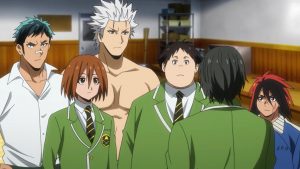 Let’s be honest, Hinomaru Zumou is probably another one for the echo chamber – a sports anime that very few English-speaking fans will be paying any attention to. I try not to let factors like that determine my blogging decisions, but I can’t deny they’re at least a part of the equation sometimes. And there is a flipside to that too – sometimes if I talk about a show like that long enough, a few more people end up giving it a chance and liking it. And as factors go, that one is and should be one of the biggest.
Let’s be honest, Hinomaru Zumou is probably another one for the echo chamber – a sports anime that very few English-speaking fans will be paying any attention to. I try not to let factors like that determine my blogging decisions, but I can’t deny they’re at least a part of the equation sometimes. And there is a flipside to that too – sometimes if I talk about a show like that long enough, a few more people end up giving it a chance and liking it. And as factors go, that one is and should be one of the biggest.
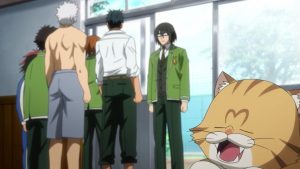 I still don’t know whether Hinomaruzumou is going to be one of those shows that’s so good it demands that kind of Sisyphean effort, but I think there’s at least a chance it will be – and almost none that it wouldn’t be good enough to cover if I set reader indifference aside. “Old school” is one of those terms that gets tossed around with sports anime an awful lot, sometimes (like “slice of life” with other genres) incorrectly. But I do think it applies to this series, which approaches the most traditional of Japanese sports with the most traditional of sports manga construction. Fittingly it’s a series that’s all about the heavy lifting – and in that sense, rather an odd fit for Shounen Jump.
I still don’t know whether Hinomaruzumou is going to be one of those shows that’s so good it demands that kind of Sisyphean effort, but I think there’s at least a chance it will be – and almost none that it wouldn’t be good enough to cover if I set reader indifference aside. “Old school” is one of those terms that gets tossed around with sports anime an awful lot, sometimes (like “slice of life” with other genres) incorrectly. But I do think it applies to this series, which approaches the most traditional of Japanese sports with the most traditional of sports manga construction. Fittingly it’s a series that’s all about the heavy lifting – and in that sense, rather an odd fit for Shounen Jump.
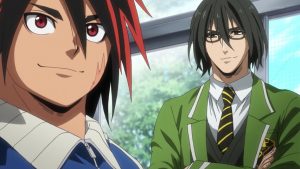 Mind you, I approach the concept of high school sumo with very little background knowledge, so I’m no authority as to how accurate the depictions of this show are – only how realistic they seem. And it does seem as if school sumo is a thing even at the elementary and middle school level here, as this episode shows. The boy we met at the end of last week’s episode is Tsuji Kirihito (Terashima Takuma), who used to do sumo but now doesn’t for reasons not yet explained. He self-appoints as the supervisor of the sumo club and promises to taken them to nationals – and the fact that Ushio (who knows him) declines to contradict him suggests that Tsuki’s bona fides are in order.
Mind you, I approach the concept of high school sumo with very little background knowledge, so I’m no authority as to how accurate the depictions of this show are – only how realistic they seem. And it does seem as if school sumo is a thing even at the elementary and middle school level here, as this episode shows. The boy we met at the end of last week’s episode is Tsuji Kirihito (Terashima Takuma), who used to do sumo but now doesn’t for reasons not yet explained. He self-appoints as the supervisor of the sumo club and promises to taken them to nationals – and the fact that Ushio (who knows him) declines to contradict him suggests that Tsuki’s bona fides are in order.
 Tsuji’s first act as supervisor is to set up practice matches with sumo powerhouse Eiga High School, runner-up at the last inter-high. The bait he uses involves another boy who used to do sumo and now doesn’t for reasons that are explained, Kuze Sousuke (Takeuchi Sunsuke). He’s involved with the Eiga team and trains with them, but doesn’t participate in matches because he’s been forbidden to by his father, a Yokozuna. Kuze injured Ushio in a match in elementary (perhaps one of the scars can be explained) and his father banned him from the circle until he learned to control his strength.
Tsuji’s first act as supervisor is to set up practice matches with sumo powerhouse Eiga High School, runner-up at the last inter-high. The bait he uses involves another boy who used to do sumo and now doesn’t for reasons that are explained, Kuze Sousuke (Takeuchi Sunsuke). He’s involved with the Eiga team and trains with them, but doesn’t participate in matches because he’s been forbidden to by his father, a Yokozuna. Kuze injured Ushio in a match in elementary (perhaps one of the scars can be explained) and his father banned him from the circle until he learned to control his strength.
 We’ve obviously seen this route before – the noob school starts the long path to nationals by taking on a powerhouse in a practice match. But this isn’t a case of trying to win – it’s more about level-setting and gaining experience. In fact Kunisaki does win his match, taking advantage of his wrestling repertoire, though Yuuma and (especially) Kei are dispatched with predictable ease and even Shinya goes down without too much resistance. But the moment of truth comes when Ushio steps into the ring – not against Kuze (at first) but against Kariya Shun (young Yoshinaga Takuto).
We’ve obviously seen this route before – the noob school starts the long path to nationals by taking on a powerhouse in a practice match. But this isn’t a case of trying to win – it’s more about level-setting and gaining experience. In fact Kunisaki does win his match, taking advantage of his wrestling repertoire, though Yuuma and (especially) Kei are dispatched with predictable ease and even Shinya goes down without too much resistance. But the moment of truth comes when Ushio steps into the ring – not against Kuze (at first) but against Kariya Shun (young Yoshinaga Takuto).
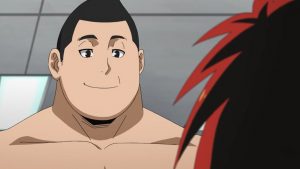 This matchup is both interesting and educational, because it presents a contrast in approach. Like Ushio Kariya was betrayed by a lack of growth in middle school, but rather than persist in a head-on approach, he changed his style to one better-suited to his stature. Riding that change he won the middle school lightweight crown (apparently in some amateur competitions there are weight classes after all) and made the open-weight quarterfinals. Given that, the fact that Ushio defeats him here – albeit after a very tough battle – gives some context as to just how strong Ushio is.
This matchup is both interesting and educational, because it presents a contrast in approach. Like Ushio Kariya was betrayed by a lack of growth in middle school, but rather than persist in a head-on approach, he changed his style to one better-suited to his stature. Riding that change he won the middle school lightweight crown (apparently in some amateur competitions there are weight classes after all) and made the open-weight quarterfinals. Given that, the fact that Ushio defeats him here – albeit after a very tough battle – gives some context as to just how strong Ushio is.
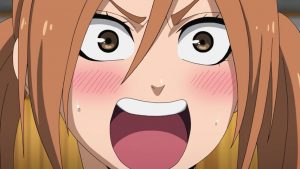 Seeing this gets Kuze’s juices flowing, and he finally relents to facing Ushio in the ring – an act which may have some consequences for the Eiga team. As for the bout itself, it again reflects just how good Ushio really is – he doesn’t win, but neither does he lose, and Kuze seems like he’s about as good as it gets in amateur sumo. Again I can’t say whether this is realistic or not – maybe a guy Ushio’s height would have no chance against someone like Kuze – but the way Hinomaru Zumou presents the bout it does play that way. That’s to the series’ credit, and another example of how its determined, measured approach to its story is working very well thus far.
Seeing this gets Kuze’s juices flowing, and he finally relents to facing Ushio in the ring – an act which may have some consequences for the Eiga team. As for the bout itself, it again reflects just how good Ushio really is – he doesn’t win, but neither does he lose, and Kuze seems like he’s about as good as it gets in amateur sumo. Again I can’t say whether this is realistic or not – maybe a guy Ushio’s height would have no chance against someone like Kuze – but the way Hinomaru Zumou presents the bout it does play that way. That’s to the series’ credit, and another example of how its determined, measured approach to its story is working very well thus far.


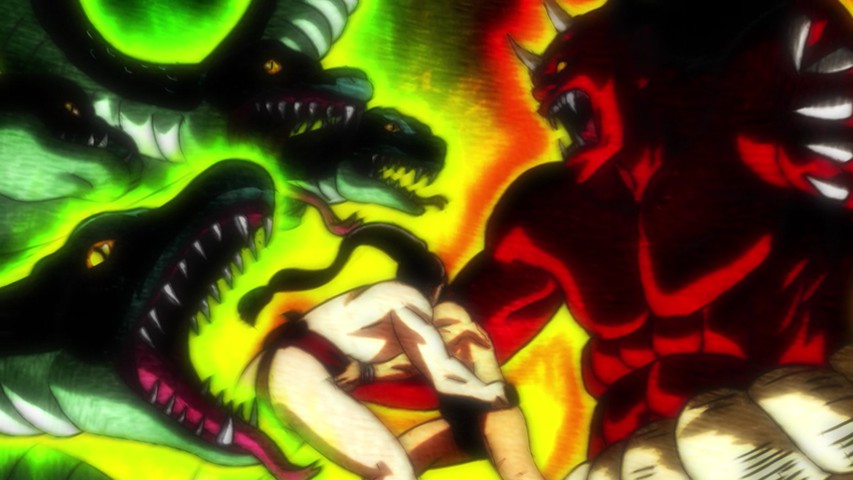
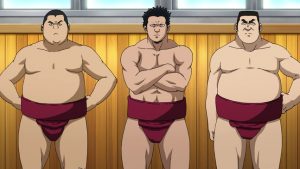


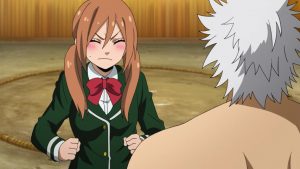

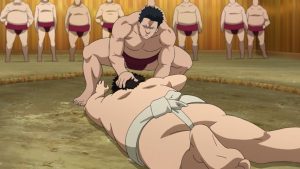

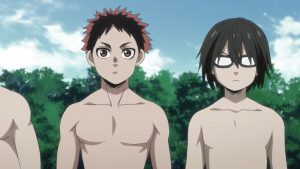
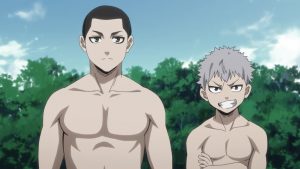
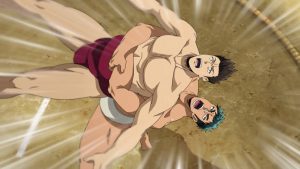
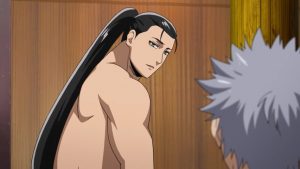
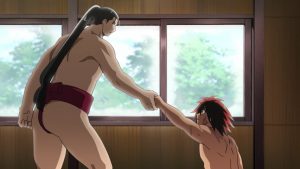
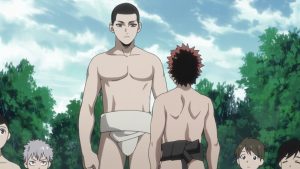
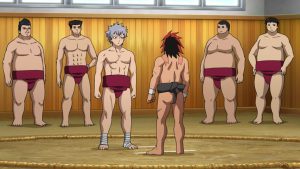
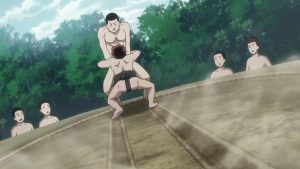
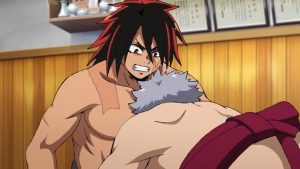

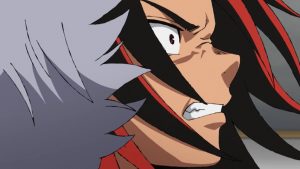
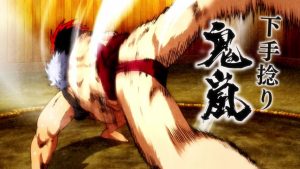
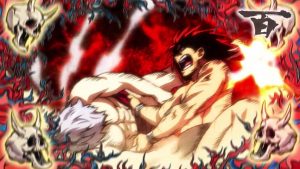

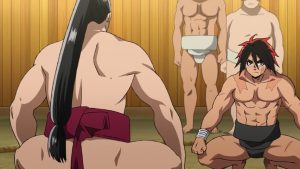
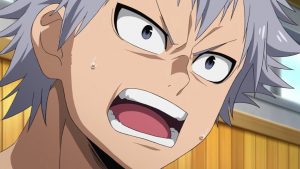
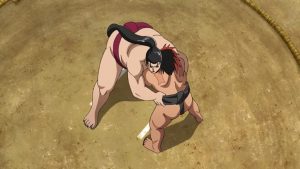
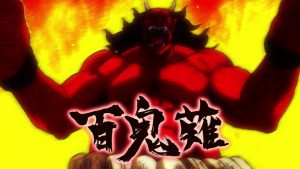
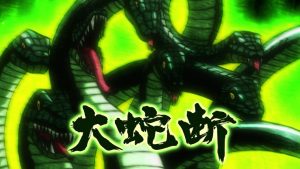
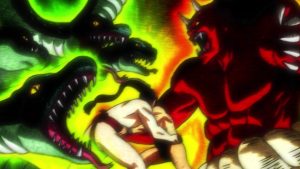
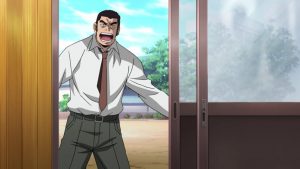
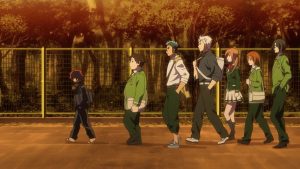
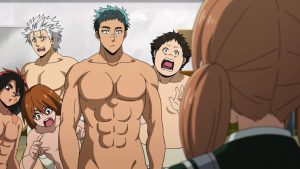


Collectr
October 20, 2018 at 9:04 pmEnzo, have faith in your own judgment. This is a good show with a novel subject, and like Ginga e Kickoff, it has its fans and will have more as you spread the word. What’s the point of reviewing trope-fests that slavishly copy the latest trend? Champion the underdogs!
And yeah, this goes for Gurazeni as well.
Guardian Enzo
October 20, 2018 at 9:39 pmThat’s what I tell myself when I waver, so thanks for the reinforcement.
JJ
October 22, 2018 at 7:15 amI’m on board.
Nadavu
November 2, 2018 at 8:54 amI’m not an authority on sumo either, but I do watch it on TV from time to time, and one of the most interesting aspects of the sport is that the bigger guy doesn’t always win. In fact, to my unprofessional eye, the really massive fighters are usually in a disadvantage against smaller, more agile opponents, who can turn their momentum against them.
but speaking of realism, the first episode threw that out of the window with the Yuma fight. I don’t care how strong mentally and physically you are–no one can take 15 minutes of pummeling straight to the face and brush it aside like it was nothing, especially if the guy doing the beating is an experienced karateka. Maybe he can take one punch without going down, but after three, there’s no way he’s still standing. After the dozens Yuma had delivered, Ushio should by all rights be dead, and not just in the “if you lose, you die” sense.